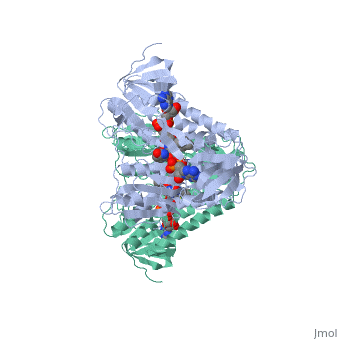Dihydrolipoamide dehydrogenase
From Proteopedia
| Line 5: | Line 5: | ||
==Structure== | ==Structure== | ||
| - | This complex in E. coli consists of 24 E2 proteins arranged in a cube, surrounded by 12 E1 proteins and 12 E3 proteins. More specifically, structurally speaking, Dihidrolipoamide dehydrogenase (E3) binds to the pyruvate dehydrogenase complex (and the center of the cube of E2 proteins) through a <scene name='Nicholas_Rockefeller_Sandbox/E3_plus_e3_binding_protein/1'>coupling with E3 binding protein</scene>.‘<ref>PMID:16442803</ref>’ The active site includes an FAD group, as well as <scene name='Nicholas_Rockefeller_Sandbox/Cys43cys48/3'>Cys 43 and Cys 48</scene> forming a disulfide bond. When the substrate is not present, <scene name='Nicholas_Rockefeller_Sandbox/Tyr181/2'>Tyr 181</scene> “covers” the catalytic site from being exposed to solvents. Dihidrolipoamide dehydrogenase (E3) is a SCOP alpha and beta (a/b) class protein of the FAD/NAD(P)-binding domain fold. | + | This complex in E. coli consists of 24 E2 proteins arranged in a cube, surrounded by 12 E1 proteins and 12 E3 proteins. More specifically, structurally speaking, Dihidrolipoamide dehydrogenase (E3) binds to the pyruvate dehydrogenase complex (and the center of the cube of E2 proteins) through a <scene name='Nicholas_Rockefeller_Sandbox/E3_plus_e3_binding_protein/1'>coupling with E3 binding protein</scene>.‘<ref>PMID:16442803</ref>’ The E3 binding protein is a completely separate protein from E3, but serves to connect the E3 polypeptides to the overarching structure. The active site includes an FAD group, as well as <scene name='Nicholas_Rockefeller_Sandbox/Cys43cys48/3'>Cys 43 and Cys 48</scene> forming a disulfide bond. When the substrate is not present, <scene name='Nicholas_Rockefeller_Sandbox/Tyr181/2'>Tyr 181</scene> “covers” the catalytic site from being exposed to solvents. Dihidrolipoamide dehydrogenase (E3) is a SCOP alpha and beta (a/b) class protein of the FAD/NAD(P)-binding domain fold. |
==Mechanism== | ==Mechanism== | ||
Revision as of 20:59, 23 March 2010
Contents |
Dihydrolipoamide dehydrogenase (E3)
| |||||||||
| 1lvl, resolution 2.45Å () | |||||||||
|---|---|---|---|---|---|---|---|---|---|
| Ligands: | , | ||||||||
| Activity: | Dihydrolipoyl dehydrogenase, with EC number 1.8.1.4 | ||||||||
| |||||||||
| |||||||||
| Resources: | FirstGlance, OCA, PDBsum, RCSB | ||||||||
| Coordinates: | save as pdb, mmCIF, xml | ||||||||
General
Dihidrolipoamide dehydrogenase (E3) is a part of the multienzyme complex of pyruvate dehydrogenase. The multienzyme complex catalyzes the formation of Acetyl-CoA from pyruvate. This reaction takes place through oxidative decarboxylation.
Structure
This complex in E. coli consists of 24 E2 proteins arranged in a cube, surrounded by 12 E1 proteins and 12 E3 proteins. More specifically, structurally speaking, Dihidrolipoamide dehydrogenase (E3) binds to the pyruvate dehydrogenase complex (and the center of the cube of E2 proteins) through a .‘[1]’ The E3 binding protein is a completely separate protein from E3, but serves to connect the E3 polypeptides to the overarching structure. The active site includes an FAD group, as well as forming a disulfide bond. When the substrate is not present, “covers” the catalytic site from being exposed to solvents. Dihidrolipoamide dehydrogenase (E3) is a SCOP alpha and beta (a/b) class protein of the FAD/NAD(P)-binding domain fold.
Mechanism
Mechanistically, the redox reaction occurs through the influence of , between which there is a disulfide bond within a distorted alpha helix. This redox active disulfide bond becomes reduced in order to reoxidize the E2 enzyme of the multienzyme complex.‘[2]’ E2 donates electrons (and protons) to E3 in order to complete its catalytic cycle. The E3 enzyme’s flavin ring (FAD) funnels electrons from the disulfide bond to itself, , reoxidizing the E3, and leaving it ready for the beginning of its catalytic cycle again.
- ↑ Brautigam CA, Wynn RM, Chuang JL, Machius M, Tomchick DR, Chuang DT. Structural insight into interactions between dihydrolipoamide dehydrogenase (E3) and E3 binding protein of human pyruvate dehydrogenase complex. Structure. 2006 Mar;14(3):611-21. Epub 2006 Jan 26. PMID:16442803 doi:10.1016/j.str.2006.01.001
- ↑ Voet, Donald et al. 2008. Fundamentals of Biochemistry. 3rd ed. pp.570-575
Proteopedia Page Contributors and Editors (what is this?)
Michal Harel, Nicholas Rockefeller, Alexander Berchansky, David Canner, Shane Michael Evans, Jaime Prilusky


